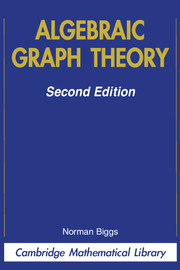Book contents
- Frontmatter
- Contents
- Preface
- 1 Introduction
- PART ONE LINEAR ALGEBRA IN GRAPH THEORY
- PART TWO COLOURING PROBLEMS
- PART THREE SYMMETRY AND REGULARITY
- 15 Automorphisms of graphs
- 16 Vertex-transitive graphs
- 17 Symmetric graphs
- 18 Symmetric graphs of degree three
- 19 The covering-graph construction
- 20 Distance-transitive graphs
- 21 Feasibility of intersection arrays
- 22 Imprimitivity
- 23 Minimal regular graphs with given girth
- References
- Index
17 - Symmetric graphs
Published online by Cambridge University Press: 05 August 2012
- Frontmatter
- Contents
- Preface
- 1 Introduction
- PART ONE LINEAR ALGEBRA IN GRAPH THEORY
- PART TWO COLOURING PROBLEMS
- PART THREE SYMMETRY AND REGULARITY
- 15 Automorphisms of graphs
- 16 Vertex-transitive graphs
- 17 Symmetric graphs
- 18 Symmetric graphs of degree three
- 19 The covering-graph construction
- 20 Distance-transitive graphs
- 21 Feasibility of intersection arrays
- 22 Imprimitivity
- 23 Minimal regular graphs with given girth
- References
- Index
Summary
The condition of vertex-transitivity is not a very powerful one, as is demonstrated by the fact that we can construct at least one vertex-transitive graph from each finite group, by means of the Cayley graph construction. A vertex-transitive graph is symmetric if and only if each vertex-stabilizer Gv acts transitively on the set of vertices adjacent to v. For example, there are just two distinct 3-regular graphs with 6 vertices; one is K3,3 and the other is the ladder L3. Both these graphs are vertex-transitive, and K3,3 is symmetric, but L3 is not because there are two ‘kinds’ of edges at each vertex.
Although the property of being symmetric is apparently only slightly stronger than vertex-transitivity, symmetric graphs do have distinctive properties which are not shared by all vertex-transitive graphs. This was first demonstrated by Tutte (1947a) in the case of 3-regular graphs. More recently his results have been extended to graphs of higher degree, and it has become apparent that the results are closely related to fundamental classification theorems in group theory. (See 17a, 17f, 17g.)
We begin by defining a t-arc [α] in a graph Г to be a sequence (α0, α1,…, αt) of t + 1 vertices of Г, with the properties that {αi−1, αi} is in EГ for 1 ≤ i ≤ t, and αi−1 ≠ αi+1 for 1 ≤ i ≤ t − 1. A t-arc is not quite the same thing as the sequence of vertices underlying a path of length t, because it is convenient to allow repeated vertices.
- Type
- Chapter
- Information
- Algebraic Graph Theory , pp. 130 - 137Publisher: Cambridge University PressPrint publication year: 1974
- 2
- Cited by

